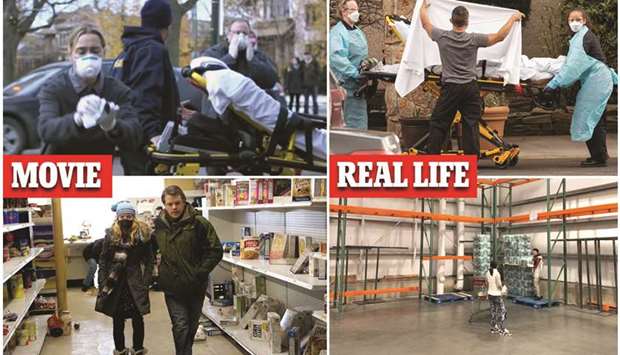The 2011 movie will scare you into soap and water. It makes that precaution seem as urgent as the inevitable moment in a horror film when viewers want to yell at the screen, “Get out of the house … now!”
The coronavirus outbreak has turned life in 2020 into a nervous waiting game for updates. What’s the latest headline? Which events have been cancelled? Why aren’t there enough test kits? How many states have declared an emergency?
This week, even James Bond went into quarantine, so to speak. The release of the 007 movie No Time To Die was moved from April to November over worries about theatre closings in Italy, South Korea, China and Japan — all countries hit hard by Covid-19, the abbreviated name for the virus.
Anxiety is rising. So is the number of people watching Contagion, a well-crafted drama that until recently was relatively forgotten. It’s become a hot rental at online sites like Amazon Prime and iTunes.
Why is everyone so eager to see something that is guaranteed to freak them out? Maybe it’s the lure of facing your nightmares. As director Barry Jenkins (Moonlight) told The New York Times, “I was really curious to see how well it would line up to what is happening right now, it was shocking. It felt like I was watching a documentary that has all these movie stars playing real people.”
Nowhere is that more evident than in a scene where CNN’s Dr Sanjay Gupta — yes, the real guy did a cameo — is interviewing a Centers for Disease Control expert played by Laurence Fishburne.
“Our best defence has been social distancing, no handshaking, staying home when you’re sick, washing your hands frequently,” says Fishburne.
That sounds like a clip from every cable news channel right this minute.
Art imitates life so closely in such sequences that you may wonder if the rest of the movie is going to come true. That’s a frightening prospect, because the screenplay by Scott Z Burns envisions catastrophic loss.
But Contagion is fiction, and the coronavirus, as bad as it’s been, hasn’t reached the devastation levels of the movie’s imaginary MEV-1 virus.
In real life, Covid-19, first detected in Wuhan, China, in December 2019, has resulted globally in more than 100,000 cases and over 3,300 deaths. So far in America, over 200 cases have been confirmed, with at least 15 deaths linked to the virus (but there are concerns about undiagnosed cases due to early coronavirus test shortages).
In the film, the MEV-1 virus is unleashed in Minneapolis by Gwyneth Paltrow’s character after a business trip to Hong Kong. Within a month, the death toll in America is at 2.5 million. The worldwide total reaches 26 million.
The coronavirus puts the elderly and those with underlying medical conditions at the most risk. The movie’s virus hits the old, young and middle-aged like a freight train. Spoiler alert: Paltrow’s death in the first 20 minutes or so reveals this is no ordinary flu.
Contagion is a worst-case scenario with an A-list cast. Matt Damon portrays Paltrow’s husband, an everyman dad struggling to hold things together for his teenage daughter. Laurence Fishburne, Kate Winslet and Marion Cotillard play dedicated public health experts. Jude Law is intense and reckless as a conspiracy-chasing blogger, while Jennifer Ehle is equally impulsive, but in a heroic way, as a CDC laboratory scientist racing to find a vaccine.
Soderbergh’s 9-year-old movie is a master class in creating suspense out of inanimate objects. Early on, Paltrow’s character sits in a Chicago airport bar, coughing as she waits for a delayed flight. The camera pans to all the places her germs are spreading: the bowl of nuts that she’s been eating from, the credit card she hands to the bartender, the machine where the card is swiped.
Remember how Jaws kept you out of the water? Contagion makes an equally fierce case for not touching your face — or anything, really.
As clues pop up in Hong Kong, London and Tokyo that a pandemic is emerging, Fishburne and his CDC team must scramble to identify and contain the virus. They track clusters of infections at health clubs and elementary schools and, in Winslet’s case, put their own lives at risk by travelling to investigate the sites.
Meanwhile, rumours multiply that the virus is actually a military or industrial weapon. Law touts a natural cure, forsythia, on his blog without any solid proof, then brags about having 12 million unique visitors to his website. One of the movie’s more gratifying scenes is when a veteran scientist played by Elliott Gould blasts Law’s careless journalistic standards. “Blogging is not writing,” barks Gould. “It’s graffiti with punctuation.”
Contagion floats many plot twists that echo what is known about Covid-19, like its connecting the origin of the fictional virus to bats and pigs. Recently, in real life, China banned the wildlife trade over suspicions that exotic animal infected humans.
In the movie, a National Guard armoury is turned into a vast triage centre for bed-ridden patients. In real-world Wuhan, China, where Covid-19 was first detected, two hospitals were constructed in a little over a week’s time to deal with the crisis.
Yet Contagion takes things to awful extremes. At various points in the story, rioting and looting breaks out for food and supplies. Quarantines and curfews are enacted in cities. A grieving Damon can’t find a funeral home that will take his wife’s body. Eventually, mass graves are necessary to deal with the fatalities.
Contagion feels overwhelming, but don’t mistake it for a guidebook. It’s just a creative exercise that carries a powerful message about fighting fear with knowledge.
The movie will convince you that the more facts you have, the better off you are. Now is the time to prepare. Learn what preventive measures you should be taking. Seek information from legitimate sources and avoid the unproven theories and scams littering social media.
This is serious stuff, and it’s not over yet, not by a long shot. You don’t need to sit through Contagion to know that. But it is one heck of a reminder to keep washing your hands. — Detroit Free Press/TNS



